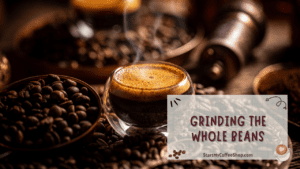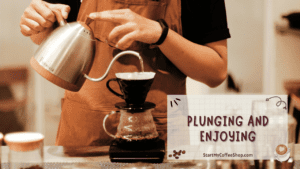Nothing beats making a cup of coffee from whole beans for coffee aficionados. The journey from grinding the beans to plunging and sipping the delectable brew is an art that lifts the coffee-drinking experience to new heights. Unlike pre-ground coffee, utilizing whole beans allows you to experience the entire spectrum of flavors and smells that the beans have to offer.
To make coffee with whole beans, start by grinding them to a medium consistency. Use 1 tablespoon of coffee grounds for every 6 ounces of water. Pour hot water over the ground, allowing it to steep for about 4 minutes. After that, plunge the coffee and savor the delightful brew.
In this article, we will dig into the intriguing world of making coffee using whole beans, guiding you through each stage of the process to guarantee you produce a cup that represents the essence of these amazing beans. So, prepare to embark on a voyage of coffee craftsmanship that will awaken your senses and leave you with a renewed respect for the art of brewing.
Grinding the Whole Beans

For coffee connoisseurs, the meticulous art of grinding whole beans to a medium consistency marks the start of the process of brewing the ideal cup of coffee. This important procedure plays a vital part in extracting the entire flavors and fragrances of the coffee beans in addition to guaranteeing the freshness of the coffee. To enjoy the genuine essence of the coffee in all its grandeur, grind the beans right before brewing, as opposed to using pre-ground coffee, which tends to lose its flavor over time.
The choice of the grinder when grinding whole beans has a significant impact on the final cup. To achieve more consistent results, a burr grinder is strongly advised over a blade grinder. The burr grinder grinds the beans evenly and uniformly by crushing them between two rough surfaces. A blade grinder, on the other hand, fragments the beans into different sizes, causing an inconsistent extraction during the brewing process.
It is advised to set the burr grinder to a medium coarse setting, similar to the texture of granulated sugar, to obtain the optimal grind size for brewing. With a balance between surface area exposure and flavor extraction, this consistency enables the best extraction possible during the brewing process. The coffee’s natural flavors are extracted while avoiding excessive bitterness thanks to a medium grind, which guarantees that water permeates the grounds consistently.
It is crucial to avoid over-extraction, which is a typical mistake among coffee connoisseurs, by not grinding the beans too finely. A greater surface area is exposed to water in finely ground coffee, which causes an excessive release of bitter chemicals. A bitterness that is unpleasant and unduly powerful can result from the water’s prolonged interaction with the small particles, which may hide the intricacies of the coffee’s flavor profile.
It takes some trial and error and awareness of one’s taste preferences to find the ideal grind size. As a general rule, coarser grinds work better for lengthier brewing processes like cold brew or French press because they call for a slower extraction process. On the other hand, speedier brewing techniques like espresso, where water just briefly comes into touch with the grounds, benefit more from finer grinds.
Read more about: Cost of Opening a Drive-Thru Coffee Shop: From Dollars to Decaf
The Coffee-to-Water Ratio
When brewing coffee from whole beans, the ratio of coffee to water is crucial since it determines how flavorful and enjoyable the final product will be. To guarantee that the strengths and tastes of the coffee are harmoniously extracted and that your brew properly suits your taste preferences, it’s critical to get this ratio just right.
A generally acknowledged rule of thumb is to use one spoonful of coffee grounds for every 6 ounces of water as a starting point. When starting your coffee-making journey using whole beans, you can use this ratio as a handy guide because it has worked well for many coffee connoisseurs. But it’s important to keep in mind that making coffee is an art and that everyone has different preferences.
The benefit of using whole beans to make coffee is that you may experiment with different coffee-to-water ratios and create the perfect cup of coffee. Consider adding more coffee grounds in proportion to the water if you want a bolder, stronger brew. On the other hand, lower the coffee grounds while maintaining the same water volume for a gentler and lighter cup.
It’s crucial to keep a few vital considerations in mind when you start your investigation of various ratios. First, think about the coffee beans’ origin and degree of roasting. Different beans have different intensities and flavor characteristics, which can affect the appropriate coffee-to-water ratio. For example, darker roasts typically have a stronger flavor, demanding a somewhat higher ratio to produce a well-balanced cup.
The efficiency of the ratio will also be impacted by the brewing technique you use. There are different amounts of extraction for techniques like the French press, pour-over, and espresso machines, thus adjusting the ratio of coffee to water may be necessary to maintain taste balance. When perfecting your brewing technique, take into account how grind size, water temperature, and steeping duration interact with the coffee-to-water ratio.
Coffee brewing has the fun feature of allowing you to record notes and keep track of your experimentation. Keeping track of the many ratios you experiment with, along with their accompanying tastes, strengths, and brewing techniques, can offer insightful information and help you hone your perfect coffee-to-water ratio over time.
Keep in mind that taste is a personal matter, so what one person may deem to be the ideal cup of coffee may not be the same for another. Accept the path of exploration and don’t be afraid to stray from the recommended ratios to find the distinctive flavors that appeal to your palate.
Pouring Hot Water and Steeping
The stage is prepared for the most fascinating step in the coffee-making process—the actual brewing—with the coffee beans properly ground and the coffee-to-water ratio carefully calculated. The magic starts to work at this point, changing the mixture of water and coffee grinds into a symphony of flavors and aromas.
Bring fresh, filtered water to a rolling boil to start the brewing process. enable the water to sit for a second after it reaches boiling to enable the temperature to drop just a little. The use of boiling water can scorch the delicate coffee grounds, removing undesired bitter compounds and reducing the intricacies of the coffee’s flavors. This little moment of patience is essential.
When the water has slightly cooled, it is time to start the process of turning the coffee grounds into a delicious elixir. Put the coffee grounds in the brewing device of your choice, whether it be a French press, pour-over cone, or another technique of your choice. Each brewing technique has distinctive qualities and nuances that affect the final flavor of the coffee.
As you get ready to move on to the next step, take time to relax and enjoy the enticing aroma of freshly ground coffee. Pour the hot water over the coffee grinds slowly and deliberately, using a steady hand and a soft touch. A balanced and reliable extraction is made possible by this meticulous pouring, which makes sure that all of the coffee grounds are evenly wet.
When hot water first comes in contact with anxious coffee grinds, a captivating dance between the two substances begins. The water permeates the grinds, emulsifying and drawing out the plethora of tastes that are there. It is crucial to retain patience and refrain from speeding the procedure during this crucial stage. The water has plenty of time to perform its magic and delicately tease out the subtleties of the coffee’s character by steeping the beans for about 4 minutes.
The water and coffee grinds interact during the steeping process, gradually releasing the flavor of the beans. The ultimate flavor profile of the brew is determined by the extraction process, which is a delicate balancing act where time, temperature, and grind size all come together. The result is a flavor that is well-rounded and nuanced and is distinguished by the special qualities of the coffee beans you chose and grind with care.
The duration of the steeping procedure, which is a key phase, can considerably affect the coffee’s overall flavor and strength. A softer brew is produced by a shorter steeping period, allowing the coffee’s more delicate tastes to stand out. On the other hand, a longer steeping period enhances the flavor of the coffee by drawing out deeper and richer tastes from the grounds.
A sensory symphony of aroma and flavor is produced as the coffee reaches its pinnacle of infusion as the seconds pass. It’s time to conclude the brewing process and enjoy the fruits of your labor after the captivating 4-minute voyage. The next step is to separate the coffee grounds from the liquid, whether you use a French press and gently press down the plunger, a pour-over method, or any other approach.
Particularly the French press excels in keeping the fine sediments and vital oils, resulting in a coffee with a richer body and velvety texture. Regardless of the method you select, the end product is a cup of coffee that captures the flavor of the carefully chosen beans and showcases the artistry of the entire coffee-making process, from grinding to brewing.
Plunging and Enjoying

The concluding act in the enthralling symphony of coffee brewing is now set with the completion of the steeping process: the plunge. The next stage for those who have decided to use the French press as their preferred brewing technique entails softly pressing down the plunger to separate the coffee grounds from the liquid, producing a smooth and velvety brew that is guaranteed to please the senses.
The French press, commonly referred to as a press pot or plunger pot, is a well-known and cherished coffee brewing apparatus. Its straightforward yet clever construction enables a hands-on, immersive brewing experience that preserves the integrity of the coffee with the least amount of interruption. The mesh filter, which efficiently separates the coffee grounds from the liquid during the plunging process, is the key to the French press’s growth.
The mesh filter activates when you gently depress the plunger, expertly capturing the coffee grounds at the base of the French press. This clever design keeps the coffee’s fine sediments and vital oils, which are typically lost or filtered out by standard brewing techniques. The result is a richer, fuller-bodied coffee that stands out for its velvety texture and rich flavor.
As you prepare to enjoy the product of your painstaking coffee-making process, the anticipation grows as you pour the freshly separated coffee into your preferred cup. An alluring invitation to explore the wonderful flavor that awaits is extended by the aroma that emerges from the cup.
The tastes dance over your palate as you take your first sip, revealing the complex subtleties and qualities of the coffee beans you carefully picked and ground. Your taste buds are enveloped by the velvety texture, which leaves behind a lovely mouthfeel that lingers and entices you to enjoy every sip to the fullest.
The simplicity and adaptability of the French press, in addition to its capacity to produce a tasty brew, are what make it so attractive. The process is simple enough for coffee lovers of all experience levels, making it a preferred option for both novices and seasoned connoisseurs.
In addition to being simple to use, the French press gives you the freedom to experiment with different brewing conditions, enabling you to make coffee that is specifically tailored to your preferences. You may fine-tune your brew to obtain the precise flavor profile that tantalizes your taste buds by modifying the grind size, water temperature, steeping duration, and coffee-to-water ratio.
To guarantee that your French press continues to make good coffee for many mornings to come, it is crucial to take care of it. Future brews won’t taste off because of lingering coffee grounds and oils thanks to routine cleaning and maintenance. After plunging, make sure to take apart the French press and thoroughly clean the parts to get rid of any leftover coffee grounds that can result in a subpar cup.
Read more about: Cost of Opening a Small Coffee Shop: The Financial Roadmap
Frequently Asked Questions

Why is complete coffee bean grinding required for brewing?
The freshness and flavor of the entire coffee beans are preserved by grinding them right before brewing. Coffee beans start to lose their fragrance and oils once they are ground, which results in a cup with less flavor. The coffee’s full potential is extracted by grinding just before brewing, producing a richer and more aromatic beverage.
Can I change the coffee-to-water ratio to suit my tastes?
Without a doubt! To suit different palates, the coffee-to-water ratio can be changed. To make a stronger or milder cup of coffee, you can experiment with other ratios in addition to the traditional advice of 1 tablespoon of coffee grounds for every 6 ounces of water. Feel free to adjust the ratio to your preference, but keep in mind that doing so may affect the coffee’s flavor and intensity.
How long should the coffee simmer before I plunge it?
The answer is that four minutes is the ideal steeping period for coffee. During this time, the hot water draws out the characteristics of the coffee grinds, giving the beverage a full-bodied flavor. However, according to the intensity you want, you can change the steeping time. While a longer steeping time will enhance the coffee’s flavor, a shorter steeping time will provide a milder brew. Try out several steeping times to see which one best matches your palette.
To learn more on how to start your own coffee shop, check out my startup documents here.
Disclaimer: The information provided by StartMyCoffeeShop.com (“The Site”) is for general informational purposes only. All information on the Site is provided in good faith. However, we make no representation or warranty of any kind, express or implied, regarding the accuracy, adequacy, validity, reliability, availability, or completeness of any information on the Site. Under no circumstance shall we have any liability to you for any loss or damage of any kind incurred as a result of the use of the Site or Reliance on any information provided on the Site. Your use of the Site and reliance on any information on the Site is solely at your own risk. This blog post is for educational purposes only and does not constitute legal advice. Please consult a legal expert to address your specific needs. Terms and Conditions. (https://startmycoffeeshop.com/terms-and-conditions/)

Hi! I’m Shawn Chun
My adventure in coffee began when I first launched my first coffee shop back in the early 2000s. I had to figure out so many things on my own and to make it worse within 2 years of opening two large corporate coffee chains moved in just blocks away from me!
As I saw smaller and even some larger coffee shops in the neighborhood slowly lose customers to these giant coffee chains and slowly close up shop, I knew that I had to start getting creative…or go out of business.
I (like you may be) knew the coffee industry well. I could make the best latte art around and the foam on my caps was the fluffiest you have ever seen. I even had the best state-of-the-art 2 group digital Nuova Simonelli machine money could buy. But I knew that these things alone would not be enough to lure customers away from the name brand established coffee shops.
Eventually, through lots of trial and error as well as perseverance and creativity I did find a way to not only survive but also thrive in the coffee/espresso industry even while those corporate coffee chains stayed put. During those years I learned to adapt and always faced new challenges. It was not always easy, however, in the end, I was the sole survivor independent coffee shop within a 10-mile radius of my location. Just two corporate coffee chains and I were left after that year. All told the corporate coffee chains took down over 15 small independent coffee shops and kiosks and I was the last one standing and thriving.
Along the years I meet others with the same passion for coffee and I quickly learned that it is not only “how good a barista is” that makes a coffee shop successful, but the business side of coffee as well.
Hence why I started this website you are on now. To provide the tools and resources for up and coming coffee shop owners to gain that vital insight and knowledge on how to start a coffee shop successfully.
Stick around, browse through my helpful blog and resources and enjoy your stay! With lots of LATTE LOVE!
Shawn







